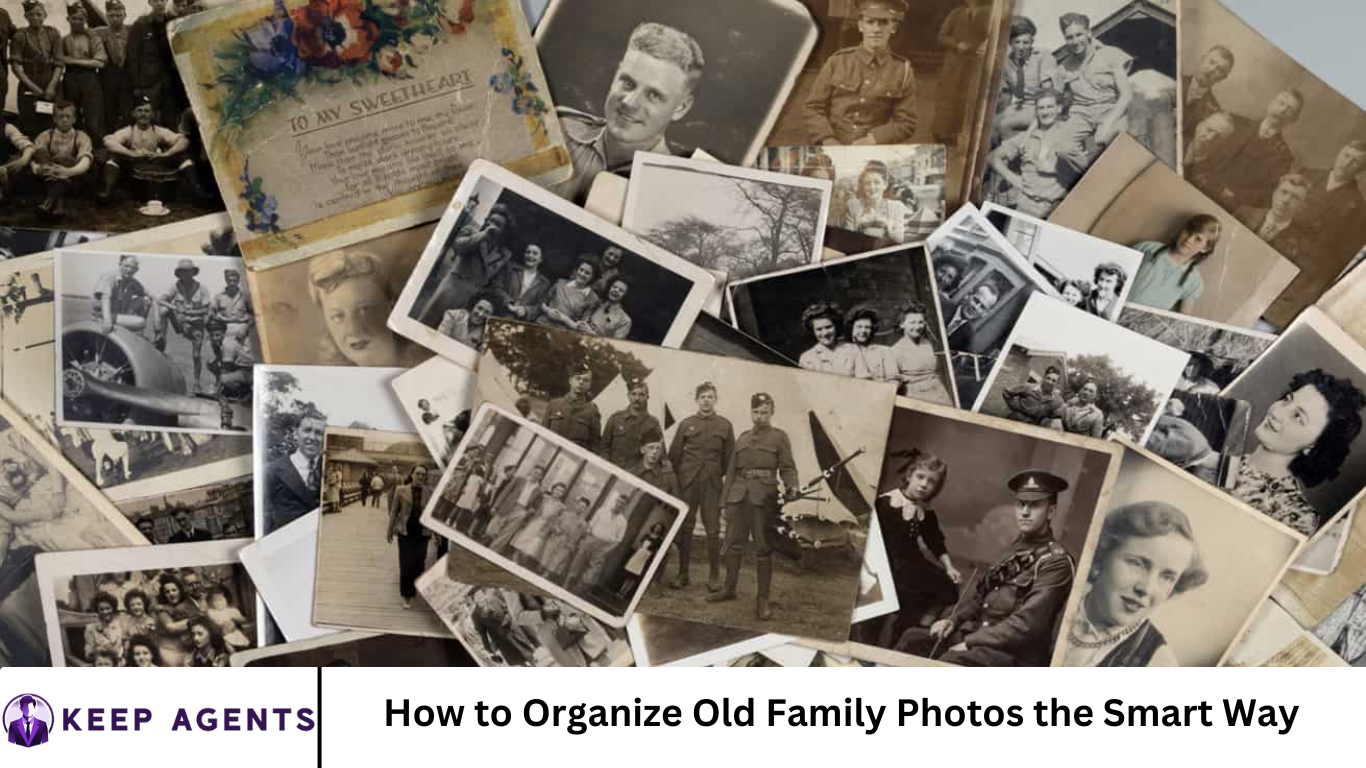Do you have boxes of old family photos stashed away in closets, basements, or attics—fading, curling, and collecting dust? If so, you’re not alone. Many of us inherit or accumulate piles of prints, photo albums, film negatives, and slides with the best of intentions, but over time, they become cluttered and disorganized.
Organizing old family photos isn’t just about tidying up—it’s about preserving memories, creating legacy archives, and making those precious moments accessible to future generations.
Whether you’re tackling your own collection or helping a parent or grandparent, this guide will walk you through how to organize old family photos the smart way—with practical steps, smart tools, and helpful tips to make the process rewarding, not overwhelming.
More Read: 10 Creative Ideas to Preserve Your Vacation Memories Forever
Why Organizing Old Photos Matters
Before diving into the how-to, let’s talk about why this project is worth your time:
- Preservation: Photos degrade over time, especially in poor storage conditions. Organizing them can help protect them for decades to come.
- Legacy: A well-organized archive makes it easier to share family stories and pass them down.
- Decluttering: Get rid of duplicates, blurry shots, and irrelevant images to reduce storage needs.
- Accessibility: With digital backups, you can easily share photos with family members or use them for gifts, scrapbooks, or memorial projects.
Step 1: Gather Everything in One Place
Start by gathering all your photos, albums, slides, negatives, and memorabilia in one central location. This might take some time if you’ve got photos stored in multiple spots. Don’t forget to check:
- Closets
- Old photo albums
- Shoe boxes and storage bins
- Attics, basements, and garages
- Relatives’ homes (ask family members if they have photos to contribute)
As you collect items, group them roughly by format: prints, albums, slides, negatives, digital files (more on digital later).
Step 2: Set Up a Sorting Station
Designate a clean, flat workspace with good lighting where you can spread things out. Here’s what you’ll need:
- Acid-free gloves (optional but helpful for handling delicate prints)
- Sticky notes or index cards for labeling
- Archival storage boxes or folders
- A trash bin/recycle box for discards
- A notebook or spreadsheet for tracking progress
If you’re working with a relative, consider setting up a shared space where you can sit and sort together. It can be a great way to spark memories and stories.
Step 3: Sort Photos by Person, Theme, or Chronology
There’s no “right” way to organize photos—it depends on your family, your goals, and your collection. Here are some popular methods:
1. Chronological Sorting
Organize photos by year or decade. This is ideal for documenting family history or creating timeline-based photo books.
2. By Person or Family Unit
Group photos by individual or branch of the family tree. Great for personalized photo gifts or legacy projects.
3. By Event or Theme
Weddings, birthdays, holidays, vacations—grouping by life events makes it easier to tell cohesive stories.
Start with broad categories, then get more detailed. Label stacks or folders as you go (e.g., “1980s – Johnson Family Vacations”).
Step 4: Eliminate Duplicates and Low-Quality Photos
As you sort, don’t be afraid to declutter ruthlessly. Ask yourself:
- Is this photo blurry or damaged beyond repair?
- Do I have a better version of this moment?
- Does this photo have meaning or value?
Keep the best version of each moment and toss unnecessary duplicates or irrelevant images. If tossing originals feels wrong, consider scanning them before discarding.
Step 5: Decide Which Photos to Digitize
Digitizing your old photos helps preserve them and makes them easy to share. You don’t need to scan everything—prioritize:
- Irreplaceable family moments
- Oldest or most fragile prints
- Unique images (weddings, baby photos, etc.)
- Photos tied to key family history milestones
You can scan photos yourself with a flatbed scanner or photo scanning app (like Google PhotoScan or Photomyne), or hire a professional digitizing service like:
- ScanMyPhotos
- Legacybox
- Memories Renewed
Be sure to scan at 300–600 DPI resolution for high-quality digital images.
Step 6: Store Originals Safely
Preserve the physical photos you’re keeping using archival-quality storage. Avoid cardboard boxes, adhesive albums, or plastic sleeves that can degrade over time. Look for:
- Acid-free photo boxes
- Lignin-free folders or envelopes
- Archival albums with photo-safe sleeves
Store photos in a cool, dry, dark environment—no attics, basements, or garages. Avoid areas with high humidity or temperature fluctuations.
Label your boxes clearly (e.g., “Smith Family Photos – 1960s–1970s”) and store them vertically like books to avoid warping.
Step 7: Organize Digital Files Smartly
Once your photos are digitized, it’s time to create a smart system for organizing digital images. Follow these tips:
Use Consistent File Naming
Use a standard naming format such as:
YYYY-MM-DD_Event_People_Location.jpg
Example: 1987-06-15_Graduation_JaneSmith_HighSchool.jpg
Create Folders by Decade or Theme
Structure your folders in a way that’s intuitive:
CopyEditFamily_Photos/
├── 1950s/
├── 1960s/
├── Birthdays/
├── Weddings/
Back Everything Up
Always store your digital archive in at least three places:
- Computer or external hard drive
- Cloud storage (Google Photos, iCloud, Dropbox, Amazon Photos)
- Off-site or physical backup (a second hard drive stored elsewhere)
Consider using automatic backup tools to sync and protect your photo library.
Step 8: Involve the Family
Organizing family photos can be a collaborative project. Invite relatives to help:
- Identify people or events in mystery photos
- Share copies of meaningful images
- Collect stories, letters, or context to add to your archive
Use tools like Ancestry, MyHeritage, or FamilySearch to tie photos to your family tree. Some apps let you tag family members and add metadata, turning your digital photo library into a rich family history resource.
Step 9: Share and Celebrate
Once your photo archive is organized, share it! Here are some ways to make your hard work shine:
- Create a digital slideshow for a family reunion
- Make photo books for gifts (Mixbook, Shutterfly, Chatbooks)
- Start a private family photo site using platforms like SmugMug or Google Photos
- Print a photo wall or gallery in your home
Celebrating the results keeps the memories alive and can inspire other family members to contribute their own photos.
Best Photo Organization & Storage Products
Here are some top-rated tools to help you stay organized:
Photo Storage Boxes
- Iris USA Photo Keeper – stackable, includes multiple 4×6 cases
- Archival Methods Acid-Free Photo Boxes – ideal for long-term preservation
Scanners
- Epson FastFoto FF-680W – fast batch scanning with auto enhancements
- Canon CanoScan LiDE400 – affordable and high-quality flatbed scanner
Cloud Storage
- Google Photos – excellent AI-powered organization, face recognition
- Dropbox – flexible cloud folder structure
- Amazon Photos – free unlimited photo storage with Prime
Frequently Asked Question
What’s the best way to start organizing a large collection of old family photos?
Start by gathering all your photos in one place—including prints, albums, negatives, and slides. Then sort them into broad categories (like by decade, person, or event). Don’t aim for perfection from the start; just focus on getting everything visible and loosely grouped before fine-tuning your system.
Should I digitize all my old photos, or just some of them?
You don’t need to digitize everything. Prioritize the most meaningful, irreplaceable, or fragile photos, such as early family portraits, special events, and deteriorating prints. Keep lower-priority ones in physical storage unless you have time or budget to scan them all.
What’s the safest way to store physical photos long-term?
Use archival-quality, acid-free boxes or folders. Avoid plastic sleeves made from PVC, magnetic “sticky” albums, and storage in basements or attics. Keep photos in a cool, dry, dark place—ideally around 68°F with low humidity.
How do I organize digital copies of my scanned photos?
Use a consistent folder structure (e.g., by decade or event) and name files clearly using a format like: YYYY-MM-DD_Event_People_Location.jpg. Backup your digital files in at least three places—cloud storage, an external drive, and a separate physical location.
How can I identify people or places in unlabeled photos?
Ask relatives for help—especially older family members who may recognize faces or locations. Use photo organizing apps like Google Photos, which can use facial recognition to group similar people together. You can also label photos as you go to preserve the information for future generations.
What should I do with duplicate or low-quality photos?
It’s okay to declutter and discard blurry, duplicate, or irrelevant images. Keep only the best version of each moment. If you’re unsure about tossing them, scan them first or set aside a temporary “maybe” pile.
Are there tools or apps that make organizing old photos easier?
Yes! Here are a few popular ones:
- Google Photos – great for auto-organizing and sharing
- Photomyne or Google PhotoScan – for scanning with your phone
- Forever, SmugMug, or FamilySearch Memories – for organizing and archiving family photos online
Conclusion
Organizing old family photos doesn’t have to be overwhelming—it can be a deeply meaningful way to connect with your past, preserve your heritage, and create a legacy for future generations. By following this smart, step-by-step system, you’ll turn dusty boxes of old prints into a beautifully organized photo archive—both physical and digital—that your whole family can enjoy. So gather your photos, roll up your sleeves, and start organizing the smart way—one memory at a time.


